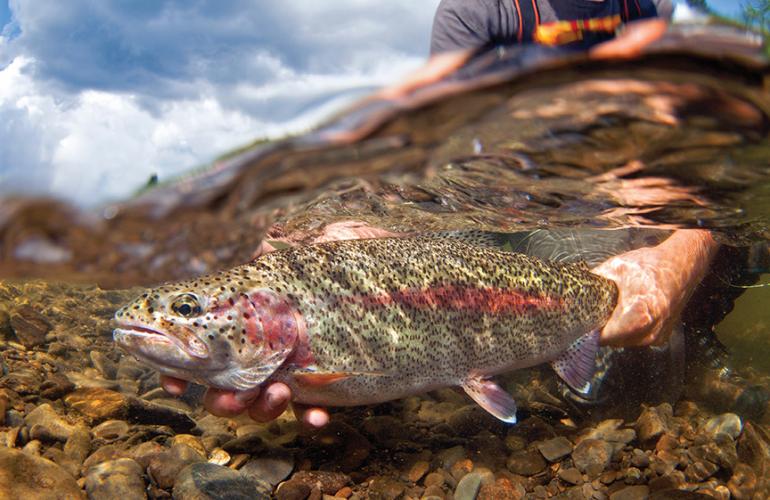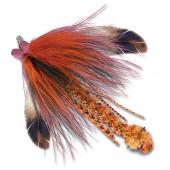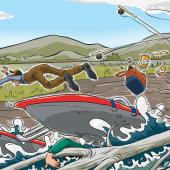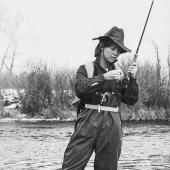Like a Fish Out of Water
The unseen impacts of catch-and-release.
Catch-and-release has become an ingrained fly-fishing habit. It’s been the only way to fish for so long, that for many, it’s hard to imagine an alternative. But is catch-and-release, as practiced, still an important tool in fish conservation and fisheries management? Or, has it become Smithsonian journalist Alastair Bland’s “wicked game of torment?” Like our prized Montana streams, one thing is crystal-clear: whatever the rationale or the ethics, fish are dying from poor handling and laissez-faire attitudes. So how can we be certain that the river’s “gift,” as Lee Wulff described trout, keeps on giving?
There’s no doubt that catch-and-release made our love of the chase okay. Motivated by conservation, catch-and-release transcended empty bellies and vulgar pot-hunting to sport hunting with an eco-conscience. Anthropologist Matt Cartmill’s “clean-plate ethic” called to many that felt uncomfortable with killing. Catch-and-release, or fishing for fun as it was originally coined, is not just fun; it makes us feel good about our generosity of spirit in giving a worthy adversary another chance at life. It’s management as morality. However, as Jack Jelinski, Montana State University Professor Emeritus, tells it, “if you fish—no matter how elegant your gear or how poetic the language you use to describe the experience—you are engaging in a behavior of predation.”
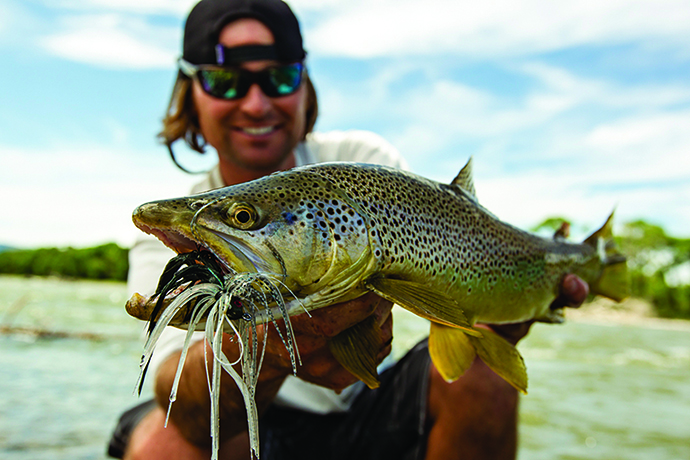
And to contain our much-debated hunting imperative, we’ve developed angling ethics. But ethics are never cut and dried. Some believe it’s wrong to chase and catch an animal for sport, and that the idea of fish feeling no pain is as ludicrous as when Descartes first theorized it. Others believe that it’s impossible for us to consider animals as equals, especially animals that live in a watery alien world with which we cannot empathize. John Varley, former chief of the Yellowstone Resources Center, and local author Paul Schullery recognized back in the 1980s that although trout are undoubtedly the most famous and celebrated residents of our waterways, there is a difference in the way fish are treated compared to other wildlife. “Even if catch-and-release killed no fish, we cannot equate the treatment of fish with the treatment of mammals; would we ever allow mammals to undergo similar treatment?” It’s hard to imagine it being legal or morally sound for people to chase deer and elk through the woods, blasting them with paintballs or tranquilizer darts.
The first time I held a fly rod, I had a perfect—albeit tiny—cutthroat on my line within seconds; I nearly peed myself with excitement. So, ethics aside, I get it. And while it’s necessary to remind ourselves of the everyday piscine inequality and pure brutality that we practice, it doesn’t necessarily matter what your angle is. Everyone is big enough and old enough to make those decisions. What matters in this conversation is how we measure the efficacy and ultimate success of catch-and-release angling. How many fish really survive? And, just as important—perhaps moreso—how many thrive? To use Paul Guernsey’s words, what’s “beyond” catch-and-release?
Somewhere in the middle of their brochure on catch-and-release fishing, the National Park Service states, “Not all fish survive when caught and released.” As with most things, to borrow a familiar editor’s phrase, “there’s a gulf between the idea and the execution.” And, there’s a boatload of factors that contribute to released-fish mortality. According to research, the big three are hooking location, handling and air exposure, and water temperature. In 2014, there were over two million angler days in Montana. According to a 1994 U.S. Fish & Wildlife Service study, an average of seven fish are caught per day—assuming these numbers are correct, that’s more than 15 million fish statewide. One-third of Montana’s angling happens in Region 3, which covers southwest Montana and the rivers we fish the most—that comes to about five million fish caught per year.
FWP’s Region 3 fisheries manager Travis Horton says that the “current literature” puts release-mortality rates around 2%, but they increased significantly with elevated water temperatures (when most angling takes place)—up to 28% for mountain whitefish on the Smith River and 8% for rainbow trout. Fighting fish to exhaustion and poor release techniques drive those figures up even higher. In 2005, researchers reviewed 53 release-mortality studies, the largest set of data yet, and concluded that two of the most favored angling species, westslope cutthroat and rainbow trout, had some of the highest mortality rates at around 22%. Based on these numbers, and assuming that the vast majority of fish caught were not kept for dinner, simple math leaves up to a million dead fish in southwest Montana rivers—a waste not tolerated when it comes to game of the four-legged kind. Even using FWP’s more conservative estimates, a minimum of 100,000 released fish die every year.
Averages, of course, can be misleading, and so far we’ve been talking average anglers—not the pros. Outfitters and their guides are paid to know where there are fish; that’s what they do, and here in Montana, they’re really good at what they do. One glance at a fishing report is enough to show that the art of fly fishing has become a technological one. Guides are out late and up early, so they know what the conditions are, and when and where the next hatch will be. Last year there were 377 licensed outfitters and guides in Montana—up by nearly a third from 2014. We’re all familiar with a “bear-jam,” but longtime fly-fisherman Jelinski tells of one caddis hatch on the Madison where “there was a glut of eight or ten guide boats, all with clients on board, queued up and chivvying for space, and pulling in so many fish that it broke my heart.”
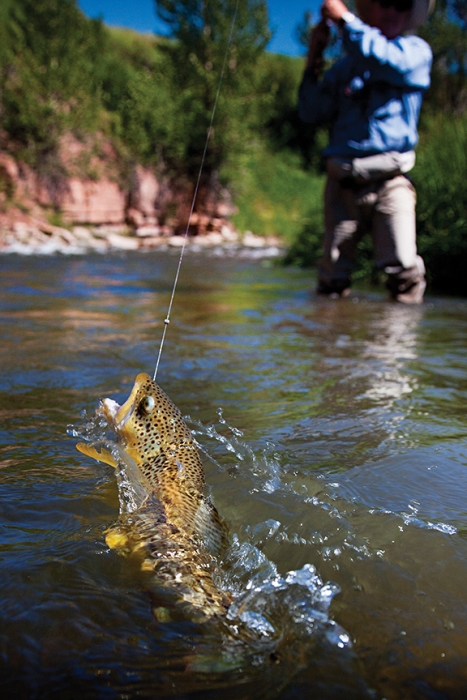
Catch-and-release may theoretically be about the chase, but for many, it’s all about the catch—as long as they don’t have to keep ‘em, that is. An old Field & Stream article reveled at the ease of catching the “cooperative” and “gullible” cutthroats in Big Sky country in the early ‘90s. You could practically hear the suitcase zippers and see waders and tackle disappearing into that distant plane hold.
More than a third of Montana’s anglers are from out of state; in fact, in 2002, the Montana Board of Outfitters reported that 97% of all guided trips were with non-residents. In North America, it is generally recognized that at least 60% of fish caught by recreational anglers are released—and that number is likely much higher in southwest Montana, where the catch-and-release ethic runs strong. In 2013, on the Madison, one of the three most-outfitted rivers in Montana, more than 80% of anglers were fly fishermen, and only one-third were residents. Considering airline baggage costs, it’s a fair bet that our out-of-state visitors prefer to take home big stories rather than big coolers. Case in point: a 2011 study reported that 94% of all fish caught in Yellowstone National Park were released. That’s probably not surprising considering that release is required for all native fish; however, more than half of the fish caught were non-native. Even 40% of the villainous lake trout were released.
In the legal case against ARCO for river pollution from mining wastes in the 1990s, researchers focused on rivers in southwest Montana. And, perhaps not surprisingly (to us anyway), the Gallatin, East Gallatin, and the Madison had the highest catch rates and bagged the most angler-hours. More than half of the 1,344 fishing trips in that study were to just five rivers: Rock Creek, the Bitterroot, the Big Hole, the Missouri, and our own perfect trout stream, the Madison. On a good day with a guide, the average angler catches over 20 fish. If we take these less-conservative, guided-trip catch numbers into account, and consider that the majority of out-of-state anglers will be releasing fish, we’re most likely experiencing significantly higher catch-and-release fish mortality than the estimates mentioned earlier—particularly in southwest Montana. This could mean up to 100,000 fish on the Madison River alone, many of them from catch-and-release angling by guided fly fishermen.
Which is not to say that guides and outfitters are the problem. Indeed, many guides are ardent conservationists and realize how important their role is in protecting fisheries. According to Matson Rogers, owner of Angler’s West in Emigrant, “As outfitters and guides, we need to make a concerted effort to teach anglers, and to be good role models—which means fewer grip-and-grin photos. It’s really important to keep the conversation going and to foster good practices.”
Furthermore, direct release mortality isn’t the only thing at issue. There’s a plethora of scientific studies that have concluded that the “sub-lethal” effects of catch-and-release angling, although highly variable, can be significant. Debilitating hook injuries can reduce a fish’s ability to feed by 50%. Not only does physical stress from capture and disturbance—especially in summer, when the water is warm and pressure at its highest—disrupt the time spent feeding, it also increases a fish’s vulnerability to other opportunistic organisms, disease, and fungal infection. Reduction in feeding results in up to a 15% reduction in fish growth, while physical stress from handling and “fighting” also increases a fish’s metabolic demand for energy. Not surprisingly, excessive playing, handling, and air exposure shoots fish stress levels through the roof. In combination, the varied responses by fish to catch-and-release angling stressors divert energy that otherwise would have been used for sperm and egg growth, causing delayed ovulation and reducing the likelihood of progeny survival.
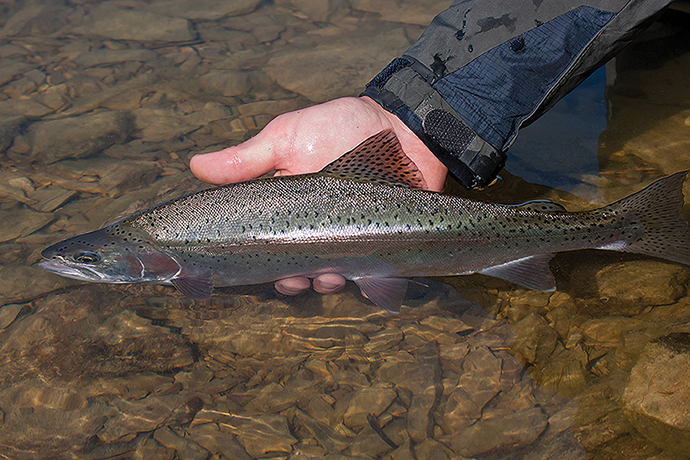
What does this amount to? Smaller, less-fit fish, and fewer of them. Horton agrees: “Montana’s fish have high fecundity, in that they have high reproductive capabilities, but there’s no doubt that fish are not attaining the sizes they used to.” Given current densities and their effect on growth, he points out, “fish are going to top out at 18-22 inches in length and stay there in most of our rivers.”
Multiple captures of individual fish, common in many trophy-trout fisheries, further compound the issues of sub-lethal injury. In 1986, researchers documented that adult cutthroat trout were recaptured up to ten times on the Yellowstone River during one fishing season (40 days), with one individual being caught four times in a 24-hour period, and others within just two hours of the first capture. Not surprisingly, researchers Aaron Batholemew and James Bohnsack calculated that the cumulative mortality risk for a fish recaptured several times increased dramatically. For example, a trout caught ten times, with a mortality rate of 22% per release, has a 90% cumulative probability of dying. Like that goldfish you had as a kid, that gift will be lucky to survive the season—and may not survive to breed. If the lifespan of a rainbow trout is seven years, what is this doing to the population as a whole?
To shorten the odds still further, there’s “delayed mortality” from stress or injuries sustained during capture. Delayed mortality can give a misleading impression that fish always survive when released. A 1992 study concluded that after exhaustive exercise and air exposure for 60 seconds, as few as 28% of rainbow survived a full 12 hours. Even when healed, debilitating jaw injuries in salmonids seriously reduce fish condition and increase vulnerability. In 2006, Yellowstone Park introduced barbless hook restrictions. At the time, Park biologist Todd Koel stated that there was no biological reason for the change. “From a mortality standpoint, we can’t justify the change,” Koel said. “But from an aesthetic and visitors’ point of view, barbless hooks help; deformed-looking fish can negatively affect [the fishing] experience.” The world’s first national park restricts the use of barbed hooks because they don’t want visitors to see ugly animals, not necessarily because barbless hooks contribute to lower mortality rates.
A few years ago, Jelinski met with USGS research biologist, Julie Meka, during a study of the catch-and-release effects on Alagnak River rainbow trout in Alaska. Meka noted that restrictions had recently been placed on the fishery due to the reported high incidence of hooking scars and decreasing fish size and abundance. Meka’s team observed that over 90% of fish caught in the study had hooking scars—over a third of these had at least one “distinctive mutilation.” The researchers also found that the use of barbed hooks increased the chance of hooking injury by 17%—and the hooks took significantly longer to remove, causing more physiological stress, and heightening the chance of delayed-release mortality. As Horton estimated in an unofficial “back of the napkin” calculation after FWP restructured bag limits, “On the upper Madison alone, 20,000 fish die each year from hooking mortality.”
Catch-and-release may have been proof of our enlightenment—just as Voltaire scrutinized Descartes’s thinking, catch-and-release anglers were looked upon as strange for not bringing home fish for supper in the early days. The entire rationale for catch-and-release was and is based on the premise that there would be fewer fish and smaller fish, unless we took action. The problem now is if we’re catching more, and releasing them incorrectly, then our situation hasn’t changed much.
To date, concern about fisheries has focused on global commercial fishing by-catch—discarded catch returned to the water. Increasingly, researchers are focusing on recreational activities, so far largely ignored. They believe that more than 30 billion angler-caught fish are released annually—on this basis there’s good reason for the shift in attention. Lack of visibility, an assumption that the scale of the problem is small, and disbelief that there is a problem, all factor into the illusion that fisheries management is the same as fisheries conservation.
Of course, bag limits and gear restrictions are one thing, but angler conduct is quite another. There’s no doubt that fish are dying from poor handling, and careless and irresponsible behavior on the river. Therefore, it seems like it’s time to promote and institute better training and wider awareness, in order to save our fisheries for the future. Meka concluded that initiating angler-education programs focusing on proper hook-removal and landing techniques would reduce injury rates and the sub-lethal effects of catch-and-release. Surprisingly, there are currently no formal education requirements for anglers, or even guides, in Montana. Which is why it’s not uncommon to see fishing guides holding trout out of the water for extended periods of time, generally for photos—a behavior their clients often mimic.
As Horton observes, “Catch-and-release has become a panacea in the industry, which is not correct at all. It is so pervasive in societal thinking that it has become like a religion—even to those who don’t fish!” It’s clear, then, that catch-and-release is not the only solution, and as a management tool it requires continuing research to monitor fish mortality, most notably the impacts of cumulative mortality from multiple hooking events, and a closer evaluation of the sub-lethal effects of catch-and-release on fish behavior, physical condition, growth, and reproduction. Earlier this year, there was a public outcry when Montana FWP tried to simplify fishing regulations on the Madison River that would have allowed more fish to be kept—regulations that have been in place since the 1980s. Horton notes, “While high fish reproduction means that fish numbers are not necessarily at risk, there is certainly concern that high angling pressure on our favorite rivers may become a problem in the future.” It’s easy to see how public pressure could fly in the face of resource protection.
In a 1994 interview, FWP biologist Dick Vincent said, “I’ve seen books written by numerous guides and outfitters that said the Madison was made by catch-and-release fishing, and that’s full of crap as far as I’m concerned. Fishing regulations are a nice tool, but they don’t have much to do with population densities. In fact, total biomass today is no better than it was before catch-and-release. All it did was rearrange biomass into sizes that anglers like better.” Vincent is the man whose research prompted the 1974 shift from hatchery-stocked rivers to the wild-trout fisheries Montana is renowned for today.
On some streams, catch-and-release is currently the only way to fish. But where there’s a choice, fresh wild trout—at ten dollars a pound in the store—might be too good a gift to pass up. Jelinski’s advice? Tune into the experience, and your baser instincts, and catch-and-kill—once in a while. As one Montana angler put it, “whatever happened to going down to the river, catching your three or four fish, and calling it a day?” What happened, of course, is that quantity overtook quality as a measure of the fishing experience, and 30 trout caught and released is now deemed superior to three trout caught, kept, and consumed. And there’s the rub: the catch-and-release community tends to consider its approach morally and ethically superior, but “harvest fishermen,” as a group, are likely having a smaller overall impact on the fishery.
Fishing for supper, not sport, might be a novel concept under the modern paradigm; but aside from helping to stem the tragic waste, there’s another reason this may be the way forward. It can be a method of keeping non-native invaders like rainbows and brown trout in check, and ensuring the survival of native fish like cutthroats. This must certainly be a more palatable (and cheaper) option than electrocution or toxic chemicals.
Regardless of one’s angle, catch-and-release is likely here to stay, and there are some good reasons for it—but anglers can take more precautions to reduce the possibility of discarded dead fish. Avoid needlessly playing or exhausting a fish; it’s not sporting and not safe for the fish. The use of natural bait increases the chances of mortality. Keep the fish in the water and never handle a fish with dry hands; use barbless hooks to reduce handling time. Just like drowning to us, air exposure to a fish is deadly. Angling in high summer temperatures almost certainly results in higher mortality. It’s not just about having great fisheries here in Montana, it’s about keeping them. We should lead the way with mandatory angler-education programs for private fishermen, guides, and outfitters.
If an injured and exhausted fish is simply tossed into the river, the gift rapidly reaches its expiration date, left to wash up on the shores of the Madison like so many misplaced flip-flops. We shouldn’t need to pick up after people using the river, and we shouldn’t need to point out the obvious. Good handling techniques, less emphasis on number of fish caught, and a greater focus on the fishing experience—all these things should speak for themselves, as we spend our days casting for trout under the big blue skies of Montana.
Bibliography
Aalbers, S. A., G. M. Stutzer, and M. A. Drawbridge. “The effects of catch-and-release angling on growth and survival of juvenile white seabass captured on offset circle and J-type hooks.” North American Journal of Fisheries Management 24 (2004): 793-800.
Aas, O., C. E. Thaling, and R. B. Ditton. “Controversy over catch-and-release fishing in Europe.” In T. J. Pitcher and C. Hollingworth (Editors) Recreational Fisheries: Ecological, Economic, and Social Evaluation, pp. 95-106. Oxford, UK: Blackwell Science. 2002.
Almodovar, A., and G. G. Nicola. “Angling impact on conservation of Spanish stream-dwelling brown trout Salmo trutta.” Fisheries Management and Ecology 11 (2004):173-182.
Andersen, W. G., R. Booth, T. A. Beddow, R. S. McKinley, B. Finstand, F. Okland, and D. Scruton. “Remote monitoring of heart rate as a measure of recovery in angled Atlantic salmon, Salmo salar.” Hydrobiologia 371 (1998): 233-240.
Anderson, R., and R. Nehring. "Effects of catch-and-release regulations on wild trout poultaion in Colorado and its acceptance by anglers." North American Journal of Fisheries Management 4 (1984): 257-265.
Arlinghaus, R., and S. J. Cooke.
Arlinghaus, R., S. J. Cooke, J. Lyman, D. Policansky, A. Schwab, C. Suski, S. G. Sutton, and E. B. Thorstad. “Understanding the complexity of catch-and-release in recreational fishing: an integrative synthesis of global knowledge from historical, ethical, social, and biological perspectives.” Reviews in Fisheries Science 15 (2007): 75-167.
Barnhart, R. A. “Symposium review: catch-and-release fishing, a decade of experience.” North American Journal of Fisheries Management 9 (1989): 74–80.
Bartholomew, Aaron, and James A. Bohnsack. "A review of catch-and-release angling mortality with implications for no-take reserves." Reviews in Fish Biology and Fisheries (Springer) 15 (2005): 129-154.
Barton, B. A., C. B. Schreck, and L. A. Sigismondi. “Multiple acute disturbances evoke cumulative physiological stress responses in juvenile Chinook salmon.” Transactions of the American Fisheries Society 115 (1986): 245–251.
Beitinger, T. L. “Behavioral reactions for the assessment of stress in fish.” Journal of the Great Lakes Research 16 (1990): 495–528.
Bendock, T., and M. Alaxandersdottir. "Hooking mortality of Chinook salmon released in the Kenai River, Alaska." North American Journal of Fisheries Management 13 (1993): 540-549.
Berkeley, S. A., M. A. Hixon, R. J. Larson, and M. S. Love. "Fisheries sustainability via protection of age structure and spatial distribution of fish poulations." Fisheries 29, no. 8 (2004): 23-32.
Bettoli, P. W., and R. S. Osborne. "Hooking mortality and behavior of striped bass following catch and release angling." North American Journal of Fisheries Management 18 (1998): 609-615.
Black, E. C. “Alterations in the blood level of lactic acid in certain salmonid fishes following muscular activity, I. Kamloops trout, Salmo gairdneri.” J. Fish. Res. Board Can, 14 (1957a): 117-134.
“Alterations in the blood level of lactic acid in certain salmonid fishes following muscular activity, II. Lake trout, Salvelinus namaycush.” J. Fish. Res. Board Can, 14 (1957b): 645-649.
“Alterations in the blood level of lactic acid in certain salmonid fishes following muscular activity, III. Sockeye salmon, Oncorhynchus.” J. Fish. Res. Board Can, 14 (1957c): 807-814.
“Hyperactivity as a lethal factor in fish.” J. Fish. Res. Board Can, 15 (1958): 573-586.
Bland, Alastair. “Catch and Release: A Wicked Game?” Retrieved from Smithsonian.com: http://www.smithsonianmag.com/travel/catch-and-release-a-wicked-game-22396707/?no-ist (19 January, 2012).
Booth, R. K., J. D. Kieffer, K. Davidson, A. T. Bielak, and B. L. Tufts. "Effects of late-season catch and release angling on anaerobic metabolism, acid-base status, survival, and gamete viability in wild Atlantic Salmon (Salmosalar)." Canadian Journal of Fisheries and Aquatic Science 52 (1995): 283-290.
Bouck, G. R., and R. C. Ball. "Influence of capture methods on blood characteristics and mortality in the rainbow trout (Salmo gairdneri)." Trans. American Fisheries Society 95 (1966): 170-176.
Boyd, James W. “Effects of Water Temperature and Angling on Mortality of Salmonids in Montana Streams.” Masters thesis. Montana State University, Bozeman, Montana, 2008.
Brett, J. R. “The respiratory metabolism and swimming performance of young sockeye salmon.” Journal of the Fisheries Research Board of Canada 21 (1964): 1183-1226.
“Environmental factors and growth.” In W. S. Hoar, D. J. Randall and J. R. Brett (Editors) Fish Physiology, Vol. VIII, pp. 599-675. New York: Academic Press. 1979.
Brobbel, M.A., M. P. Wilkie, K. Davidson, J. D. Kiefter, A. T. Bielak, and B. L. Tufts. “Physiological effects of catch and release angling in Atlantic salmon (Salmo salar) at different stages of freshwater migration.” Canadian Journal of Fisheries and Aquatic Science 53 (1996): 2036–2043.
Bruesewitz, R. E., D. W. Coble, and F. Copes. “Effects of deflating the expanded swim bladder on survival of Burbot.” North America Journal of Fisheries Management 13 (1993): 346–348.
Burns, K. M., and V. Restrepo. “Survival of reef fish after rapid depressurization: Field and laboratory studies.” American Fisheries Society Symposium 30 (2002): 148-151.
Busacker, G. P., I. R. Adelman, and E. M. Goolish. Growth. In C.B. Schreck and P. B. Moyle (Editors) Methods for Fish Biology, pp. 363-387. Bethesda, MD, USA: American Fisheries Society. 1990.
Calow, P. “Adaptive aspects of energy allocation.” In: P. Tytler and P. Calow (Editors), Fish Energetics: New Perspectives, pp. 13-31. Baltimore, MD, USA: Johns Hopkins University Press. 1985.
Campbell, P. M., T. G. Pottinger, and J. P. Sumpter. “Stress reduces the quality of gametes produced by rainbow trout.” Biology of Reproduction 47 (1992): 1140–1150.
Cartmill, Matt. A View To a Death in the Morning: Hunting and Nature through History. Cambridge, Massachusetts: Harvard University Press, 1993.
Casillas, E. and L. S. Smith. “Effect of stress on blood coagulation and haematology in rainbow trout (Salmo gairdneri).” Journal of Fish Biology 10 (1977): 481–491.
Clapp, D. F. and R. D. Clark. “Hooking mortality of Smallmouth bass caught on live minnows and artificial spinners.” N. American Journal of Fisheries Management 9 (1989): 81–85.
Cone, R. S. “The need to reconsider the use of condition indices in fishery science.” Transactions of the American Fisheries Society 118 (1989): 510-514.
Contreras-Sanchez, W. M., C. B. Schreck, M. S. Fitzpatrick, and C. B. Pereira. “Effects of stress on the reproductive performance of rainbow trout (Oncorhynchus mykiss).” Biology of Reproduction 58 (1998): 439–447.
Cooke, S. J., D. P. Philipp, J. F. Schreer, and R. S. McKinley. “The influence of terminal tackle on injury, handling time, and cardiac disturbance of rock bass.” N. Am J. Fisheries Management 21 (2001): 333-342.
Cooke S. J., J. F. Schreer, D. H. Wahl, and D. P. Philipp. “Physiological impacts of catch-and-release angling practices on largemouth bass and smallmouth bass.” In D. P. Philipp and M. S. Ridgway (Editors) Black Bass: Ecology, Conservation, and Management, pp. 489-512. Bethesda, MD, USA: American Fisheries Society. 2002.
Cooke, S. J., and C. D. Suski. “Are circle hooks an effective tool for conserving marine and freshwater recreational catch-and-release fisheries?” Aquatic Conservation of Marine Freshwater Ecosystems 14 (2004): 299–326.
Cooke, S. J., and C. D. Suski. “Do we need species-specific guidelines for catch-and-release recreational angling to conserve diverse fishery resources?” Biodiversity and Conservation 14 (2005): 1195-1209.
Cooke, Steven J., and Gene R. Wilde. “The Fate of Fish Released by Recreational Anglers.” In S. J. Kennelly (Editor) By-catch Reduction in the World’s Fisheries, pp. 181-234. Springer, 2007.
Conover, D.O., and S. B. Munch. “Sustaining fisheries yields over evolutionary time scales.” Science 297 (2002): 94–96.
Dayton, P. K. “Reversal of the burden of proof in fisheries management.” Science 279 (1998): 821–822.
Dedual, M. “Observed mortality of rainbow trout caught by different angling techniques in Lake Taupo, New Zealand.” North American Journal of Fisheries Management 16 (1996): 357–363.
Dempson, B., G. Furey, and M. Bloom. “Effects of catch and release angling on Atlantic salmon, Salmo salar, of the Conne River, Newfoundland.” Fisheries Management and Ecology 9 (2002): 139-147.
Descartes, Rene. Discourse on Method, Part 5. Vol. 1. In John Cottingham, Robert Stoothoff and Dugald Murdoch (Editors and Translators), Philosophical Writings of Descartes (orig. translated by Haldane and Ross, 1911), pp. 131-140. Cambridge: Cambridge University Press, 1985.
Donaldson, E. M. “The pituitary–interrenal axis as an indicator of stress in fish.” In: A. D. Pickering (Editor), Stress and Fish, pp. 11-47. London: Academic Press. 1981
Dotson, T. “Mortalities in trout caused by gear type and angler-induced stress.” N. Am. J. Fish. Manage. 2 (1982): 60–65.
DuBois, R. B., and R. R. Dubielzig. “Effect of hook type on mortality, trauma, and capture efficiency of wild stream trout caught by angling with spinners. North American Journal of Fisheries Management 24 (2004): 609–616.
DuBois, R. B., T. L. Margenau, R. S. Stewart, P. K. Cunningham, and P. W. Rasmussen. “Hooking mortality of Northern Pike angled through ice.” N. Am. J. Fish. Manage. 14 (1994): 769–775.
England, Mike. “Catch & Release.” In Cast, p.102-103, 2015.
England, Mike, and Dave Tucker. “Release ‘Em Right.” Retrieved from Outside Bozeman: http://www.outsidebozeman.com/activities/fishing/fly/release-em-right (2015).
Falterman, B., and J. E. Graves. “A preliminary comparison of the relative mortality and hooking efficiency of circle and straight shank (‘‘J’’) hooks used in the pelagic longline industry.” In J. A. Lucy, and A. L. Studholme (Editors) Catch and Release Symposium in Marine Recreational Fisheries, pp. 80–87. American Fisheries Society Symposium. 30, Bethesda, MD. 2002.
Ferguson, R. A., and B. L. Tufts. "Physiological Effects of Brief Air Exposure in Exhaustively Exercised Rainbow Trout (Oncorhynchus mykiss): Implications for "Catch and Release" Fisheries." Canadian Journal of Fisheries and Aquatic Science 49 (1992): 1157-1162.
Fielder, D. G. and B. A. Johnson. “Walleye mortality during live-release tournaments on Lake Oahe, South Dakota.” N. Am. J. Fish. Manage. 14 (1994): 776–780.
Fisheries Research Services (FRS) Freshwater Laboratory. Rod Capture Rates of Salmon on the River Spey. FRS Freshwater Laboratory, Faskally, Perthshire, UK., 2005.
Forschungsverbund e. V. (FVB). “Do fish feel Pain? Not as humans do, study suggests.” Science Daily: www.sciencedaily.com/releases/2013/08/130808123719.htm August 2013. Retrieved on January 21, 2016.
Fornshell, Gary. "Rainbow Trout - Challenges and Solutions." Reviews in Fisheries Science (CRC Press LLC) 10, no. 3 & 4 (2002): 545-557.
Fry, F. E. J. 1971. “The effect of environmental factors on the physiology of fish.” In W. S. Hoar, and D. J. Randall (Editors) Fish physiology, pp. 1-63. Academic Press, New York, 1971.
Fulmer B. A., and R. L. Ridenhour. “Jaw injury and condition of king salmon.” California Fish and Game 53 (1967): 282–285.
Gentner, B. “National Marine Fisheries Service’s Recreational Fisheries database: application in catch-and-release behavior and angling profiling.” In J. A. Lucy, and A. L. Studholme (Editors) Catch and Release Symposium in Marine Recreational Fisheries, pp. 212-214. American Fisheries Society Symposium. 30, Bethesda, MD. 2002.
Geurink, Denny. “Big Sky Cutthroats.” In Field and Stream, pp. 72-73, April 1990.
Gjernes, T., A. R. Kronlund, and T. J. Mulligan. “Mortality of Chinook and coho salmon in their first year of ocean life following catch and release by anglers.” N. Am. J. Fish. Manage. 13 (1993): 524–539.
Graham, M. S., C. M. Wood, and J. D. Turner. “The physiological responses of rainbow trout to strenuous exercise: interactions of water hardness and environmental acidity.” Can. Journal of Zoology 60 (1982): 3153-3164.
Gregory T. R., and C. M. Wood. “The effects of chronic plasma cortisol elevation on the feeding behaviour, growth, competitive ability, and swimming performance of juvenile rainbow trout.” Physiological and Biochemical Zoology 72 (1999): 286–295.
Griffiths, Sarah. “Fish have feelings too: Expert claims creatures experience pain in the same way humans do – and should be treated better.” In Daily Mail: http://www.dailymail.co.uk/sciencetech/article-2662297/Fish-feelings-Expert-claims-creatures-experience-pain-way-humans-better-treated.html June 19, 2014. Retrieved on January 21, 2016.
Grover, A. M., M. S. Mohr, and M. L. Palmer-Zwahlen. “Hook-and-release mortality of Chinook salmon from drift mooching with circle hooks: management implications for California’s ocean sport fishery.” In J. A. Lucy, and, A. L. Studholme (Editors), Catch and Release in Marine Recreational Fisheries. American Fisheries Society Symposium, pp. 39-56. 30, Bethesda, MD. 2002.
Guernsey, Paul. Beyond Catch & Release: Exploring the Future of Fly Fishing. New York: Skyhorse Publishing, 2011.
Gustaveson, A. W., R. S. Wydoski, and G. A. Wedemeyer. “Physiological response of largemouth bass to angling stress.” Transactions of the American Fisheries Society 120 (1991): 629–636.
Guy, Christopher S., Thomas E. McMahon, Wade A. Fredenberg, Clinton J. Smith, David W. Garfield, and Benjamin S. Cox. “Diet Overlap of Top-Level Predators in Recent Sympatry: Bull Trout and Nonnative Lake Trout.” Journal of Fish and Wildlife Management 2, 2 (2011): 183-189.
Helena Independent Record (The Associated Press). “New rule means anglers must go barbless.” In Helena IR, May 3, 2006, http://helenair.com/news/state-and-regional/new-rule-means-anglers-must-go-barbless/article_9e8625de-96c4-564c-a0d1-3b9e0a14f31d.html Retrieved on January 21, 2016.
Hickley, P., C. Marsh, and R. North. “Ecological management of angling.” In: D. M. Harper and A. J. D. Ferguson (Editors), The Ecological Basis for River Management, pp. 415-425. Chichester, UK: John Wiley and Sons. 1995.
Hogan, J. “The effects of high vacuum of fish.” Trans. Am. Fish. Soc. 69 (1940): 469–474.
Horak, D. L., and W. D. Klein. “Influence of capture methods on fishing success, stamina, and mortality of Rainbow Trout (Salmo gairdneri) in Colorado.” Trans. Am. Fish. Soc. 96 (1967): 220–222.
Horwood, J. W. “No take zones: a management context.” In M. J. Kaiser and S. J. de Groof (Editors) The Effects of Fishing on Non-target Species and Habitats, pp. 302–312. Blackwell Science, Oxford. 2000.
Hulbert, P.J., and R. Engstrom-Heg. “Hooking mortality of worm-caught hatchery Brown Trout.” N.Y. Fish Game J. 27 (1980): 1–10.
Jelinski, Jack B. “Life, Death, and Catch & Release.” Retrieved from Outside Bozeman: http://www.outsidebozeman.com/activities/fishing/life-death-and-catch-release (2013).
“Dead Fish Rising.” Retrieved from Outside Bozeman: http://www.outsidebozeman.com/summer-2011/dead-fish-rising (2011).
Jenkins, T. M. “Evaluating recent innovations in bait fishing tackle and technique for catch and release of rainbow trout.” North American Journal of Fisheries Management 23 (2003): 1098–1107.
Kaeding, L. R., D. G. Carty, D. L. Mahoney, G. Boltz, and S. M. Anderson. Annual project technical report for 1994, fishery and aqautic management program. Technical Report, United States Fish Wildlife Service, Yellowstone National Park: United States Fish Wildlife Service, 1995, 38pp.
Keniry, M. J., W. A. Brotka, W. H. Horns, and J. E. Marsden. “Effects of decompression and puncturing the gas bladder on survival of tagged Yellow Perch.” N. Am. J. Fish. Manage. 16 (1996): 201–206.
Keyes, Fletcher. “Catch and Release the Right Way.” Retrieved from Outside Bozeman: http://www.outsidebozeman.com/activities/fishing/fly/catch-and-release-right-way (n.d.).
Kieffer, J. D. “Limits to exhaustive exercise in fish.” Comparative Biochemistry and Physiology 126 (2000): 161-179.
Kirby, Alex. “Fish do feel pain, scientists say.” BBC News Online: http://news.bbc.co.uk/2/hi/science/nature/2983045.stm April 30, 2003. Retrieved on January 21, 2016.
Klein, W. D. “Mortality of trout caught on artificial lures and released by fishermen.” Trans. Am. Fish. Soc. 95 (1966): 326–328.
Klein, W. D. “Mortality of Rainbow Trout caught on single and treble hooks and released.” Prog. Fish Cult. 27 (1965): 171–172.
Koel, T. M., J. L. Arnold, P. E. Bigelow, P. D. Doepke, B. D. Ertel, and M. E. Ruhl. Yellowstone Fisheries and Aquatic Sciences: Annual Report, 2011. National Park Service, Yellowstone Center for Resources, Yellowstone National Park, Wyoming, YCR-21012-03.
Law, Glenn. A Concise History of Fly Fishing. Guilford, Connecticut: The Lyons Press, 2003.
Lee, W. C., and E. P. Bergersen. “Influence of thermal and oxygen stratification on Lake Trout hooking mortality.” N. Am. J. Fish. Manage. 16 (1996): 175–181.
Likness, George A., and Patrick J. Graham. “Westslope Cutthroat Trout in Montana: Life History, Status, and Management.” American Fisheries Symposium 4 (1988): 53-60.
Lindeboom, H. J. “The need for closed areas as a conservation tool.” In M. J. Kaiser and S. J. de Groof (Editors) The Effects of Fishing on Non-target Species and Habitats, pp. 302–312. Blackwell Science, Oxford. 2000.
Lindsay, R. B., K. Schroeder, K. R. Kenaston, R. N. Toman, and M. A. Buckman. “Hooking mortality by anatomical location and its use in estimating mortality of spring Chinook salmon caught and released in a river sport fishery.” North American Journal of Fisheries Management 24 (2004): 367–378.
Lipton, J., H. Bergman, D. Chapman, T. Hillman, M. Kerr, J. Moore, and D. Woodward. Aquatic Resources Injury Assessment Report, Upper Clark Fork River Basin. Prepared by RCG/Hagler Bailly, Inc., for the State of Montana, Natural Resource Damage Litigation Program, 1995.
Loftus, A. J. “An Evaluation of Lake Trout (Salvelinus namaycush) hooking mortality in the upper Great Lakes.” Michigan Department of Natural Resources Fisheries Division Research Report no. 1941, Ann Arbor, MI. 1986.
Loftus, A. J., W. W. Taylor, and M. Keller. “An evaluation of lake trout (Salvelinus namaycush) hooking mortality in the upper Great Lakes.” Canadian Journal of Fisheries and Aquatic Sciences 45 (1988): 1473-1479.
McLeay, L. J., G. K. Jones, and T. M. Ward. National Strategy for the Survival of Released Line-caught Fish: A Review of Research and Fishery Information. Henley Beach, Australia: South Australian Research and Development Institute, 121 pp. 2002.
McMichael, G. A. “Effects of stream temperature on angling success for rainbow and brown trout.” Masters thesis. Montana State University, Bozeman, Montana, 1989.
Maitland, P. S. “Ecological impact of angling. In D. M. Harper and A. J. D. Ferguson (Editors), The Ecological Basis for River Management, pp. 443-452. Chichester, UK: John Wiley and Sons. 1995.
Malchoff, M. H., and S. W. Heins. “Short-term hooking mortality of Weakfish caught on single-barb hooks.” N. Am. J. Fish. Manage. 17 (1997): 477–481.
Malchoff, M. H., and D. B. MacNeill. Guidelines to Increase Survival of Released Sport Fish, Released Fish Survival Sport Fish Fact Sheet. Cornell cooperative extension, Sea Grant. 1995.
Marnell, L. F., and D. Hunsaker. “Hooking mortality of lure-caught cutthroat trout (Salmo clarki) in relation to water temperature, fatigue, and reproductive maturity of released fish.” Transactions of the American Fisheries Society 99 (1970): 684-688.
Mason, J. W., and R. L. Hunt. “Mortality rates of deeply hooked rainbow trout.” The Progressive Fish-Culturist 29 (1967): 87–91.
May, R. E. “Evaluation of large scale release programs with special reference to bass fishing tournaments.” Proceedings of the Annual Conference Southeastern Association of Game and Fish Commissioners 26 (1973): 325–329.
Meka, J. M. “The influence of hook type, angler experience, and fish size on injury rates and the duration of capture in an Alaskan catch-and-release rainbow trout fishery.” North American Journal of Fisheries Management 24 (2004): 1309–1321.
Meka, Julie M., and Stephen D. McCormick. “Physiological response of wild rainbow trout to angling: impact of angling duration, fish size, body condition, and temperature.” Fisheries Research 72 (2005): 311-322.
Meka, J. M., and F. J. Margraf. "Using Bioenergetic model to assess growth reduction from catch-and-release fishing and hook injury in rainbow trout, Oncorhyncus mykiss." Fisheries Management and Ecology (Blackwell Publishing Ltd.) 14 (2007): 131-139.
Midgley, Mary. Animals and Why They Matter. Athens, Georgia: University of Georgia Press, 1983.
Montana Fish Wildife and Parks. Montana Statewide Fisheries Management Plan, 2013-2018. Montana Fish Wildlife and Parks, 2012.
Morey, Edward R., William S. Breffle, Robert D. Rowe, and Donald M. Waldman. "Estimating recreational trout fishing damages in Montana's Clark Fork River basin: summary of natural resource damage assessment." Journal of Environmental Management (Elsevier Science Ltd.) 66 (2002): 159-170.
Muoneke, M. I. “Seasonal hooking mortality of Bluegills caught on natural baits.” N. Am. J. Fish. Manage. 12 (1992a): 645–649.
Muoneke, M. I. “Hooking mortality of White Crappie, Pomoxis annularis Rafinesque, and Spotted Bass, Micropterus punctulatus (Rafinesque), in Texas reservoirs.” Aquaculture. Fish. Manage. 23 (1992b): 87–93.
Muoneke, M. I., and W. M. Childress. “Hooking mortality: a review for recreational fisheries. Reviews in Fisheries Science 2 (1994): 123–156.
Murray, S. N., R. F. Ambrose, J. A. Bohnsack, L. W. Botsford, M. H. Carr, G. E. Davis, P. K. Dayton, D. Gotshall, D. R. Gunderson, M. A. Hixon, J. Lubchenco, M. Mangel, A. MacCall, D. A. McArdle, J. C. Ogden, J. Roughgarden, R. M. Starr, M. J. Tegner, and M. M. Yoklavich. “No take reserve networks: sustaining fishery populations and marine ecosystems.” Fisheries 24, no. 11 (1999): 11–25.
Nelson, K. L. “Catch-and-release mortality of striped bass in the Roanoke River, North Carolina.” N. Am. J. Fish. Manage. 18 (1998): 25–30.
Nuhfer, A. J., and G. R. Alexander. “Hooking mortality of trophy-sized wild Brook Trout caught on artificial lures.” N. Am. J. Fish. Manage. 12 (1992): 634–644.
Nussman, M. “The recreational fisher’s perspective.” Science 307 (2005): 1560–1561.
Pankhurst, N. W., and M. Dedual. “Effects of capture and recovery on plasma levels of cortisol, lactate and gonadal steroids in a natural population of Rainbow Trout.” J. Fish. Biol. 45 (1994): 1013–1025.
Pankhurst, N. W., and G. Van Der Kraak. “Effects of stress on reproduction and growth of fish. In G. K. Iwama, A. D. Pickering, J. P. Sumpter, and, C. B. Schreck (Editors) Fish Stress and Health in Aquaculture, pp. 73–93. New York: Cambridge University Press. 1997.
Pauley, G. B., and G. L. Thomas. “Mortality of anadromous coastal Cutthroat Trout caught with artificial lures and natural bait.” N. Am. J. Fish. Manage. 13 (1993): 337–345.
Pelzman, R. J. “Hooking mortality of juvenile largemouth bass, Micropterus salmoides.” California Fish and Game 64 (1978): 185–188.
Persons, S.E., and Hirsch, S.A. "Hooking mortality of Lake Trout angled through ice by jigging and set-lining." N. Am. J. Fish. Manage. 14 (1994): 664–668.
Piccolo, John J., Nicholas F. Hughes, and Mason D. Bryant. "Water velocity influences prey detection and capture by drift-feeding juvenile coho salmon (Oncorhynchus kisutch) and steelhead (Oncorhynchus mykiss irideus)." Canadian Journal of Fisheries and Aquatic Science (NRC Research Press) 65 (September 2007): 266-275.
Policansky, David. “Catch-and-Release Recreational Fishing: a Historical Perspective.” In Tony J. Pitcher and Chuck Hollingworth (Editors) Recreational Fisheries: Ecological, Economic and Social Evaluation, pp. 74. John Wiley & Sons, 2002.
Pollock, K. H., and W. E. Pine III. “The design and analysis of field studies to estimate catch-and-release mortality.” Fisheries Management and Ecology 14 (2007): 123-130.
Pope K. L., and G. R. Wilde. “Sublethal effects of catch-and-release fishing on largemouth bass. Fisheries Management and Ecology 11 (2004): 39–44.
Pope, K. L., G. R. Wilde, and D. W. Knabe. "Effect of catch-and-release angling on growth and survival of rainbow trout, onchorhynchus mykiss." Fisheries Management and Ecology (Blackwell Publishing Ltd.) 14 (2007): 115-121.
Post, J. R., M. Sullivan, S. Cox, N. Lester, C. J. Walters, E. A. Parkinson, A. J. Paul, L. Jackson, and B. J. Schuter. “Canada’s recreational fisheries: The invisible collapse?” Fisheries 27 (2002): 6-17.
Prince, E.D., Ortiz, M., and A. Venizelos. “A comparison of circle hooks and ‘‘J’’ hook performance in recreational catch and release fisheries for billfish. In J. A. Lucy and A. L. Studholme (Editors) Catch and Release Symposium in Marine Recreational Fisheries, pp. 66–79. American Fisheries Society Symposium, 30. Bethesda, MD, 2002.
Quinn, S. “Trends in regulatory and voluntary catch-and-release fishing.” In L. E. Miranda and D. R. DeVries (Editors) Multidimensional Approaches to Reservoir Fisheries Management, pp. 152-162. Bethesda, MD, USA: American Fisheries Society, Symposium 16. 1996.
Raat, A. J. P., J. G. P. Klein Breteler, and A. W. Jansen. “Effects on growth and survival of retention of rod-caught cyprinids in large keep nets.” Fisheries Management and Ecology 4 (1997): 355–368.
Reece, Parks. “Catch & Release (from life): “Take another photo, Walt!”” Art, in Outside Bozeman Spring, 2012, p. 110.
Regan, Tom, and Peter Singer. Animal Rights and Human Obligations. Prentice Hall, 1976.
Reingold, M. “Effects of displacing, hooking, and releasing on migrating adult steelhead salmon.” Transactions of the American Fisheries Society 104 (1975): 458–460.
Rose, J. D., R. Arlinghaus, S. J. Cooke, B. K. Diggles, W. Sawynok, E. D. Stevens, and C. D. L. Wynne. “Can fish really feel pain? Fish and Fisheries, 2012.
Schill, D. J. “Hooking mortality of bait-caught Rainbow Trout in an Idaho trout stream and a hatchery: implications for special-regulation management.” N. Am. J. Fish. Manage. 16 (1996): 348–356.
Schill, D. J., J. S. Griffith, and R. E. Gresswell. “Hooking mortality of cutthroat trout in a catch-and-release segment of the Yellowstone River, Yellowstone National Park.” North American Journal of Fisheries Management 6 (1986): 226–232.
Schisler, G. J., and E. P. Bergersen. “Post release hooking mortality of Rainbow Trout caught on scented artificial baits.” North American Journal of Fisheries Management 16 (1996): 570–578.
Schreck, C. B. “Accumulation and long-term effects of stress in fish.” In G.P. Moberg, and J.A. Mench (Editors) The biology of animal stress, pp. 147-158. CAB International, 2000.
Schreck, C. B., B. L. Olla, and M. W. Davis. “Behavioral responses to stress.” In G. K. Iwama, A. D. Pickering, J. P. Sumpter, and, C. B. Schreck (Editors) Fish Stress and Health in Aquaculture, pp. 145-170. New York: Cambridge University Press. 1997.
Schreer, J. F., S. J. Cooke, and R. S. McKinley. “Cardiac response to variable forced exercise at different temperatures: an angling simulation for Smallmouth Bass.” Trans. Am. Fish. Soc. 130 (2001): 783–795.
Schullery, Paul. Cowboy Trout: Western Fly Fishing As If It Matters. Helena, Montana: Montana Historical Society, 2006.
Selby, Corinne, Candy Hinz, and Don Skaar. Montana Statewide Angling Pressure Report, 2013. Montana Fish Wildlife and Parks, 2015.
Shipley, J. B. “Aquatic protected areas as fisheries management tools.” Am. Fish. Soc. Symposium. 42 (2004): 301pp.
Sokal, R. R., and F. J. Rohlf. Biometry. 2W.H., 859pp. Freeman and Co, San Francisco, CA, 1981.
Sullivan, M. G. “Active management of walleye fisheries in Alberta: Dilemmas of managing recovering fisheries.” North American Journal of Fisheries Management 23 (2003): 1343-1358.
Sumpter, J. P., J. Carragher, T. G. Pottinger, and A. D. Pickering. “The interaction of stress and reproduction in trout.” In D. R. Idler, W. Crim, and M. Walsh (Editors) Reproductive Physiology of Fish, pp. 299–302. St Johns, Canada: Memorial University Press, 1987.
Suski, C. D., S. S. Killen, S. J. Cooke, J. D. Kieffer, D. P. Philipp, and B. L. Tufts. “Physiological significance of the weigh-in during live-release angling tournaments for largemouth bass.” Transactions of the American Fisheries Society 133 (2004): 1291-1303.
Syslo, John M., Christopher S. Guy, and Benjamin S. Cox. “Comparison of Harvest Scenarios for the Cost-Effective Suppression of Lake Trout in Swann Lake, Montana.” North American Journal of Fisheries Management 33 (2013): 1079-1090.
Tang, Y., D. G. McDonald, and R. G. Boutilier. “Acid-base regulation following exercise: a comparison between freshwater and seawater-adapted rainbow trout (Salmo gairdneri).” J. Exp. Biol. 141 (1989): 407-418.
Taylor, M. J., and K. R. White. “A meta-analysis of hooking mortality of nonanadromous trout.” N. Am. J. Fish. Manage. 12 (1992): 760–767.
Thorstad, E. B., T. F. Naesje, P. Fiske, and B. Finstad. “Effects of hook and release on Atlantic salmon in River Alta, northern Norway.” Fish. Res. 60 (2003): 293-307.
Thurston, Jay Ford. Following in the Footsteps of Ernest Hemingway. Superior, Wisconsin: Savage Press, 2005.
Titus, R. G., and C. D. Vanicek. “Comparative hooking mortality of lure-caught Lahontan cutthroat trout at Heenan Lake, California.” California Fish and Game 74 (1988): 218-225.
Tomasso, A. O., J. J. Isely, and J. R. Tomasso. “Physiological responses and mortality of Striped Bass angled in freshwater.” Trans. Am. Fish. Soc. 125 (1996): 321–325.
Tufts, B. L., Y. Tang, K. Tufts, and R. G. Boutilier. “Exhaustive exercise in “wild” Atlantic salmon (Salmo salar): acid-base regulation and blood gas transport.” Can. J. Fish. Aquatic. Sci. 48 (1991): 868-874.
Turner, J. D., C. M. Wood, and D. Clark. “Lactate and proton dynamics in the rainbow trout (Salmo gairdneri).” Journal of Exp. Biology 104 (1983): 247-268.
U.S. Department of the Interior, Fish and Wildlife Service, and U.S. Department of Commerce, U.S. Census Bureau. "2011 National Survey of Fishing, Hunting, and Wildlife Associated Recreation: Montana." Survey, U.S. Fish and Wildlife Service, and U.S. Census Bureau, U.S. Department of the Interior, and U.S. Department of Commerce, Washington D. C., 2014. Retrieved from https://www.census.gov/prod/2012pubs/fhw11-nat.pdf and http://wsfrprograms.fws.gov
U.S. Department of the Interior, Fish and Wildlife Service, and U.S. Department of Commerce, U.S. Census Bureau. "1991 National Survey of Fishing, Hunting, and Wildlife Associated Recreation: Montana." Survey, U.S. Fish and Wildlife Service, and U.S. Census Bureau, U.S. Department of the Interior, and U.S. Department of Commerce, Washington DC., 1993.
U.S. Geological Survey (USGS). “Evaluating the effects of catch-and-release fishing on the hooking injury and immediate physiological response of Alagnak River rainbow trout captured by catch-and-release angling.” In USGS, Alaska Science Center, Biological Science Office – Fisheries Projects: http://www.absc.usgs.gov/research/Fisheries/Alagnak/catch_and_release.htm retrieved on November 4, 2003.
Varley, John D., and Paul Schullery. Yellowstone Fishes: Ecology, History, and Angling in the Park. Mechanicsburg, Pennsylvannia: Stackpole Books, 1998.
Van Raaij, M. T. M., D. S. S. Pit, P. H. M. Balm, A. B. Steffens, and G. E. E. J. M. Vandenthillart. “Behavioral strategy and physiological stress response in rainbow trout exposed to severe hypoxia.” Hormones Behav. 30 (1996): 85-92.
Vincent, R. E. “Some influences of domestication upon three stocks of brook trout (Salvelinus fontinalis Mitchill).” Transactions of the American Fisheries Society 89 (1960): 35–52.
Warner, K. and P. R. Johnson. “Mortality of landlocked Atlantic Salmon (Salmo salar) hooked on flies and worms in a river nursery area.” Trans. Am. Fish. Soc. 107 (1978): 772–775.
Wedemeyer, G. A., B. A. Barton, and D. J. McLeay. “Stress and acclimation.” In C. B. Schreck, and P. B. Moyle (Editors) Methods for Fish Biology, pp. 451-489. American Fisheries Society, Bethesda, MD. 1990.
Wedemeyer, G. A., D. J. McLeay, and C. P. Goodyear. “Assessing the tolerance of fish and fish populations to environmental stress: the problems and methods of monitoring.” In V. W. Cairns, P. V. Hodson, and J. O. Nriagu (Editors) Contaminant Effects on Fisheries, pp. 163–195. Toronto, Canada: John Wiley and Sons, 1984.
Wilde, G. R., M. I. Muoneke, P. W. Bettoli, K. L. Nelson, and B. T. Hysmith. “Bait and temperature effects on Striped Bass hooking mortality in freshwater.” N. Am. J. Fish. Manage. 20: (2000): 810–815.
Wilde, G. R., K. L. Pope, and R. E. Strauss. “Estimation of fishing-tournament mortality and its sampling variance.” North American Journal of Fisheries Management 23 (2003): 779–786.
Wilkie, M. P., M. A. Brobbel, K. Davidson, L. Forsyth, and B.L. Tufts. “Influences of temperature upon the postexercise physiology of Atlantic salmon (Salmo salar).” Canadian Journal of Fisheries and Aquatic Sciences 54 (1997): 503-511.
Wilkie, M. P., K. Davidson, M. A. Brobbel, J. D. Kieffer, R. K. Booth, A. T. Bielak, and B. L. Tufts. “Physiology and survival of wild Atlantic Salmon following angling in warm summer waters.” Transactions of the American Fisheries Society 125 (1996): 572–580.
Wood, C. M. “Acid-base and ion balance, metabolism, and their interactions, after exhaustive exercise in fish.” Journal of Experimental Biology 160 (1991): 285-308.
Wood, C. M., and S. F. Perry. “Respiratory, circulatory and metabolic adjustments to exercise in fish.” In R. Giles (Editor) Circulation, respiration and metabolism, p. 1-22. Springer-Verlag, Berlin, 1985.
Wood, C. M., T. D. Turner, and M. S. Graham. “Why do fish die after severe exercise?” J. Fish Biol. 22 (1983): 189–201.
Woodward, C. C., and R. J. Strange. “Physiological stress responses in wild and hatchery-reared rainbow trout.” Transactions of the American Fisheries Society 116 (1987): 574–579.
Wright, S. “A review of the subject of hooking mortalities in Pacific Salmon Oncorhynchus).” Pacific Marine Fisheries Commission Annual Report 23 (1972): 47-65.
Wulff, Lee. Lee Wulff's Handbook of Freshwater Fishing. New York: Frederick A. Stokes Company, 1939.
Wydoski, R. S. “Relation of hooking mortality and sublethal hooking stress to quality fishery management.” In: R. A. Barnhart, and T. D. Roelofs (Editors) Catch and Release Fishing: A Decade of Experience, pp. 43–87. Humboldt State University, Arcata, CA, 1977.
Wydoski, R. S., G. A. Wedemeyer, and N. C. Nelson. “Physiological response to hooking stress in hatchery and wild rainbow trout (Salmo gairdneri).” Transactions of the American Fisheries Society 105 (1976): 601–606.


